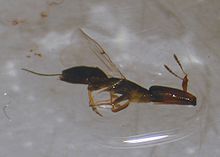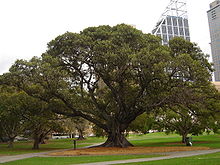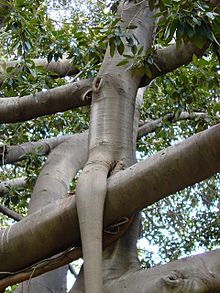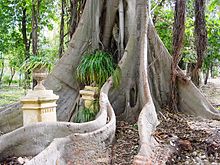- Ficus macrophylla
-
Moreton Bay Fig Ficus macrophylla (Moreton Bay Fig) Scientific classification Kingdom: Plantae (unranked): Angiosperms (unranked): Eudicots (unranked): Rosids Order: Rosales Family: Moraceae Genus: Ficus Species: F. macrophylla Binomial name Ficus macrophylla
Desf. ex Pers.Synonyms Ficus macrocarpa Hugel ex Kunth & Bouche
Ficus magnolioides[1]Ficus macrophylla, commonly known as the Moreton Bay Fig, is a large evergreen banyan tree of the Moraceae family that is a native of most of the eastern coast of Australia, from the Atherton Tableland (17° S) in the north to the Illawarra (34° S) in New South Wales, and Lord Howe Island. Its common name is derived from Moreton Bay in Queensland, Australia. It is best known for its beautiful buttress roots, which are also known for damaging municipal footpaths.
As Ficus macrophylla is a strangler fig; seed germination usually takes place in the canopy of a host tree and the seedling lives as an epiphyte until its roots establish contact with the ground. It then enlarges and strangles its host, eventually becoming a freestanding tree by itself. Individuals may reach 60 m (200 ft) in height. Like all figs, it has an obligate mutualism with fig wasps; figs are only pollinated by fig wasps, and fig wasps can only reproduce in fig flowers.
Ficus macrophylla is widely used as a feature tree in public parks and gardens in warmer climates such as California, Portugal, Italy (Sicily, Sardinia, Liguria) and Australia. Old specimens can reach tremendous size. Its aggressive root system allows its use in only the largest private gardens.
Contents
Taxonomy
The Moreton Bay fig was described by French botanist René Louiche Desfontaines. Its specific epithet macrophylla is derived from the Ancient Greek makro "large" and phyllon "leaf",[2] and refers to the size of the leaves.[3] Australian botanist Dale J. Dixon recognised two forms: Ficus macrophylla f. macrophylla, a free-standing tree which is endemic to mainland Australia and Ficus macrophylla f. columnaris, a hemiepiphyte without a distinct main trunk, which is endemic to Lord Howe Island.[4]
The generally used common name is Moreton Bay Fig,[3] after Moreton Bay in southern Queensland, although it is found elsewhere. The term has also been mistakenly generalised to other fig species in Australia. An alternate name, Black Fig, is derived from the dark colour of the ageing bark.[5]
With over 750 species, Ficus is one of the largest angiosperm genera.[6] Based on morphology, English botanist E. J. H. Corner divided the genus into four subgenera;[4] later expanded to six.[7] In this classification, the Moreton Bay fig was placed in subseries Malvanthereae, series Malvanthereae, section Malvanthera of the subgenus Urostigma.[8] In his reclassification of the Australian Malvanthera, Dixon altered the delimitations of the series within the section, but left this species in series Malvanthereae.[4]
In 2005, Cornelis Berg completed Corner's treatment of the Moraceae for the Flora Malesiana; the completion of that work had been delayed since 1972 as a result of disagreements between Corner and C. J. J. G. van Steenis, editor of the Flora Malesiana.[9] Berg combined sections Stilpnophyllum and Malvanthera into an expanded section Stilpnophyllum. This left the Moreton Bay fig in subsection Malvanthera, section Stilpnophyllum.[8]
Based on DNA sequences from the nuclear ribosomal internal and external transcribed spacers, Nina Rønsted and colleagues rejected previous subdivisions of the Malvanthera. Instead, they divided section Malvanthera into three subsections—Malvantherae, Platypodeae and Hesperidiiformes. In this system, the Moreton Bay fig is in the new subsection Malvantherae, along with F. pleurocarpa. The Malvantherae appear to be an early offshoot and basal to the group. Both species are native to Australia, with subspecies columnaris of macrophylla having colonised Lord Howe Island. Ronsted and colleagues suggest this last form might be the most ancient of the three taxa.[8] The section Malvanthera itself is thought to have evolved 41 million years ago and radiated from 35 million years ago.[7]
Description
The Moreton Bay Fig is an evergreen tree that can reach heights of 60 m (200 ft).[1] The trunk can be massive, with thick, prominent buttressing, and reach a diameter of 2.4 m (8 ft).[3] The rough bark is grey-brown,[10] and marked with various blemishes.[11] It is monoecious: each tree bears functional male and female flowers.[4] As implied by its specific epithet, it has large, elliptic, leathery, dark green leaves, 15–30 cm (6–12 in) long, and they are arranged alternately on the stems. The leaves and branches bleed a milky sap if cut or broken. The figs are 2–2.5 cm (0.75–1 in) in diameter, turning from green to purple with lighter spots as they ripen;[1] ripe fruit may be found year round,[11] although more abundant from February to May.[3] Although edible, they are unpalatable and dry.[3]
The characteristic "melting" appearance of the Moreton Bay fig is due to its habit of dropping aerial roots from its branches, which upon reaching the ground, thicken into supplementary trunks which help to support the weight of its crown.
It is a rainforest plant and in this environment more often grows in the form of an epiphytic strangler vine than that of a tree. When its seeds land in the branch of a host tree it sends aerial, 'strangler' roots down the host trunk, eventually killing the host and standing alone.[3]
Its roots are surface feeding and it is quite susceptible to earth compaction around its trunk, which is why in many locations these trees are fenced. It is water-hungry, and like many Australian trees should neither be planted in urban environments where its roots may damage piping, nor where water is scarce.
Reproduction
 Pleistodontes frogatti, the fig wasp that pollinates the Moreton Bay fig
Pleistodontes frogatti, the fig wasp that pollinates the Moreton Bay fig
Figs have an obligate mutualism with fig wasps, (Agaonidae); figs are only pollinated by fig wasps, and fig wasps can only reproduce in fig flowers. Generally, each fig species depends on a single species of wasp for pollination. The wasps are similarly dependent on their fig species in order to reproduce. The Moreton Bay fig is pollinated by the fig wasp Pleistodontes froggatti.[12]
Distribution and habitat
The Moreton Bay Fig is a native of most of the eastern coast, from the Atherton Tableland (17° S) in north Queensland, to the Shoalhaven River (34° S) on New South Wales south coast.[11] It is found in rainforest, where, as an emergent tree, its crown may tower above the canopy.[11]
Ecology
In addition to the pollinating wasp, Pleistodontes froggatti, syconia of the Moreton Bay fig are host to several species of non-pollinating chalcidoid wasps including Sycoscapter australis (Pteromalidae), Eukobelea hallami (Sycophaginae) and Meselatus sp. (Epichrysomallinae).[13] It is an important food to the fruit-eating pigeons such as the Wompoo Fruit-dove (Ptilinopus magnificus), and Topknot Pigeon (Lopholaimus antarcticus), and a sometime food of the Rose-crowned Fruit-dove (Ptilinopus regina).[14] Other bird species include the Yellow-eyed Cuckoo-shrike (Coracina lineata), Pied Currawong (Strepera graculina), Australasian Figbird (Sphecotheres vieilloti), Green Catbird (Ailuroedus crassirostris), Regent Bowerbird (Sericulus chrysocephalus), Satin Bowerbird (Ptilonorhynchus violaceus), and Lewin's Honeyeater (Meliphaga lewinii).[3] Fruit bats such as the Grey-headed Flying-fox (Pteropus poliocephalus) also feed on the fruit.[15]
The thrips species Gynaikothrips australis feeds on the underside of new leaves of F. macrophylla, as well as F. rubiginosa and F. obliqua. As plant cells die, nearby cells are induced into forming meristem tissue and a gall results, and the leaves become distorted and curl over. The thrips begin feeding when the tree has flushes of new growth, and the life cycle is around six weeks. At other times, thrips reside on old leaves without feeding. The species pupates sheltered in the bark. The thrips remain in the galls at night and wander about in the daytime and return in the evening, possibly to different galls about the tree.[16]
Potentially invasive species
 A young Moreton Bay Fig starts life as an epiphyte in an Auckland, New Zealand park
A young Moreton Bay Fig starts life as an epiphyte in an Auckland, New Zealand park
Ficus macrophylla is commonly cultivated in Hawaii and in northern New Zealand. In both places, it has now naturalised, having acquired its pollinating wasp (Pleistodontes froggatti). In Hawaii the wasp was deliberately introduced in 1921, and in New Zealand it was first recorded in 1993, having apparently arrived by long-distance dispersal from Australia. The arrival of the wasp led to prolific production of fruits containing many small seeds adapted for dispersal by birds. The Moreton Bay Fig has been found growing on both native and introduced trees in New Zealand and in Hawaii. The size and vigour of this fig in New Zealand, and its lack of natural enemies, as well as its immunity to possum browsing, indicate that it may be able to invade forest and other native plant communities.[1][17]
Uses
The Moreton Bay Fig has been widely used in public parks in frost-free areas, and was popular with early settlers of Australia.[10] Sydney has numerous specimens.[11] Specimens can reach massive proportions, and have thrived in drier climates; impressive specimen trees have been grown in the Waring Gardens in Deniliquin, and in Hay.[18]
Although their root buttressing is a potential feature, the Moreton Bay Fig is poorly suited to bonsai as their large leaves do not reduce much in size and they have long internodal growth.[19] It is can be used as an indoor plant in medium to brightly-lit indoor spaces.[20]
The soft light timber has a wavy texture and is used for cases.[3] Aborigines traditionally used the fibres for fishing nets.[3]
Notable specimens
Large specimens of Moreton Bay Fig Trees are found in many parks and properties throughout eastern and north-eastern Australia. The Brisbane and Sydney botanical gardens contain numerous specimens planted in the middle of the nineteenth century. These figs are on average of 30–35 metres in height and 40 metres in width. Currently the tallest Moreton Bay Fig is found on a cattle farm near Egg Rock in the Numinbah valley of Queensland and measured 49 metres (161 feet) in 2006. There are many large specimens in New Zealand. A Moreton Bay Fig at Pahi on the Kaipara Harbour, Northland, was measured in 1984 as 26.5 metres (86.9 feet) high and 48.5 meters (159 feet) wide.[21] Several large specimens grow in California, U.S.A.. The tallest in North America is in back of San Diego's Natural History Museum and was planted in 1914. By 1996 it stood 23.7 metres (78 feet) high and 37.4 metres (123 feet) across.[22] The widest Moreton Bay Fig in North America is the Santa Barbara's Moreton Bay Fig Tree. It was planted in 1876, reportedly by a sailor, and measured 53.6 metres (176 feet) across in 1997. It was once a tourist attraction.[23] Santa Monica resident and United States Senator John P. Jones planted a Moreton Bay Fig in a corner of his estate in 1889, which became the patio of the Miramar Hotel in 1921.[24] There is a notable specimen sprawling on steps at the Botanical Garden of the University of Coimbra, Portugal.[25] Impressive specimens also grow in several parks in Liguria (Bordighera and Sanremo) and in the Orto Botanico in Palermo, Italy, and in some squares in the oldest part of the city.
 An emergent Moreton Bay Fig in situ, estimated at fifty metres tall, Davis Scrub Nature Reserve, Australia.
An emergent Moreton Bay Fig in situ, estimated at fifty metres tall, Davis Scrub Nature Reserve, Australia.
References
- ^ a b c d Starr F, Starr K, and Loope L. Ficus macrophylla - Moreton bay fig - Moraceae United States Geological Survey--Biological Resources Division Haleakala Field Station, Maui, Hawai'i, 2003.
- ^ Liddell, Henry George and Robert Scott (1980). A Greek-English Lexicon (Abridged Edition). United Kingdom: Oxford University Press. ISBN 0-19-910207-4.
- ^ a b c d e f g h i Floyd, Alex G. (2009). Rainforest Trees of Mainland Southeastern Australia. Lismore, NSW: Terania Rainforest Publishing. pp. 231–32. ISBN 09589443673.
- ^ a b c d Dixon, Dale J. (2003). "A taxonomic revision of the Australian Ficus species in the section Malvanthera (Ficus subg. Urostigma: Moraceae)" (pdf). Telopea 10 (1): 125–53. http://www.rbgsyd.nsw.gov.au/__data/assets/pdf_file/0020/72713/Tel10Dix125.pdf.
- ^ Webber, Len (1991). Rainforest to Bonsai. East Roseville, NSW: Simon and Schuster. pp. 105. ISBN 0-7318-0237-3.
- ^ Frodin, David G. (2004). "History and concepts of big plant genera". Taxon (Taxon, Vol. 53, No. 3) 53 (3): 753–76. doi:10.2307/4135449. JSTOR 4135449. http://www.ingentaconnect.com/content/iapt/tax/2004/00000053/00000003/art00012.
- ^ a b Rønsted, Nina; Weiblen, George D.; Clement, W. L.; Zerega, N. J. C.; Savolainen, V. (2008). "Reconstructing the phylogeny of figs (Ficus, Moraceae) to reveal the history of the fig pollination mutualism". Symbiosis 45 (1–3): 45–56. http://geo.cbs.umn.edu/RonstedEtAl2008a.pdf.
- ^ a b c Rønsted, Nina; Weiblen, George D.; Savolainen, V; Cook, James M. (2008). "Phylogeny, biogeography, and ecology of Ficus section Malvanthera (Moraceae)". Molecular Phylogenetics and Evolution 48 (1): 12–22. doi:10.1016/j.ympev.2008.04.005. PMID 18490180. http://geo.cbs.umn.edu/RonstedEtAl2008b.pdf.
- ^ Weiblen, G. D.; W. L. Clement (2007). "Flora Malesiana. Series I. Volume 17 parts 1 & 2". Edinburgh Journal of Botany 64 (3): 431–37. doi:10.1017/S0960428607064311. http://geo.cbs.umn.edu/Weiblen&Clement2007.pdf.
- ^ a b Holliday, Ivan (1989). A Field Guide to Australian Trees. Melbourne: Hamlyn Australia. p. 198. ISBN 0-947334-08-4.
- ^ a b c d e Fairley A, Moore P (2000). Native Plants of the Sydney District:An Identification Guide (2nd ed.). Kenthurst, NSW: Kangaroo Press. pp. 62. ISBN 0-7318-1031-7.
- ^ Lopez-Vaamonde, Carlos; Dale J. Dixon, James M. Cook, Jean-Yves Rasplus (2002). "Revision of the Australian species of Pleistodontes (Hymenoptera: Agaonidae) fig-pollinating wasps and their host-plant associations". Zoological Journal of the Linnean Society 136 (4): 637–83. doi:10.1046/j.1096-3642.2002.00040.x. http://www3.interscience.wiley.com/journal/118944298/abstract.
- ^ Bean, Daniel; James M. Cook (2001). "Male mating tactics and lethal combat in the nonpollinating fig wasp Sycoscapter australis". Animal Behaviour 62 (3): 535–42. doi:10.1006/anbe.2001.1779.
- ^ Innis, Gary John (1989). "Feeding Ecology of Fruit Pigeons in Subtropical Rainforests of Southeast Queensland". Aust. Wildl. Res. 16 (4): 365–94. doi:10.1071/WR9890365.
- ^ Eby., P.. "Diet Species of the Grey-headed Flying-fox in the Sydney Region". Ku-ring-gai Bat Conservation Society Inc.. http://www.sydneybats.org.au/cms/index.php?id=11,60,0,0,1,0. Retrieved 2009-05-03.
- ^ Tree, Desley J; Walter, G. H. (2009). "Diversity of host plant relationships and leaf galling behaviours within a small genus of thrips –Gynaikothrips and Ficus in south east Queensland, Australia". Australian Journal of Entomology 48 (4): 269–75. doi:10.1111/j.1440-6055.2009.00706.x.
- ^ Gardner, Rhys O.; John W. Early (1996). "The naturalisation of banyan figs (Ficus spp., Moraceae) and their pollinating wasps (Hymenoptera: Agaonidae) in New Zealand". New Zealand Journal of Botany 34: 103–10. http://www.rsnz.org/publish/nzjb/1996/115.php.
- ^ de Beuzeville WAW (1947). Australian Trees for Australian Planting. Sydney: Forestry Commission of New South Wales/ A. H. Pettifer, Government Printer. pp. 47–48.
- ^ Koreshoff, Dorothy and Vita (1984). Bonsai with Australian native Plants. Brisbane: Boolarong Publications. pp. 52. ISBN 0-908175-663.
- ^ Ratcliffe, David & Patricia (1987). Australian Native Plants for Indoors. Crows Nest, NSW: Little Hills Press. pp. 90. ISBN 0-949773-49-2.
- ^ S.W. Burstall and E.V. Sale (1984). Great Trees of New Zealand. Wellington: Reed. pp. 39. ISBN 0-589-01532-X.
- ^ "Ficus macrophylla: Moreton Bay Fig" SDNHM Botany Department.
- ^ The Santa Barbara Fig Tree
- ^ 20. Miramar Moreton Bay Fig Tree Santa Monica Landmarks
- ^ Pakenham, Thomas (2002). Remarkable Trees of the World. London: Weidenfeld & Nicolson. pp. 146–47. ISBN 0-297-84300-1.
- George, A. S. Flora of Australia, CSIRO Publishing, 1980. ISBN 0-643-05702-1
- Jousselin, E.; J. Rasplus, F. Kjellberg (2003). "Convergence and coevolution in a mutualism: evidence from a molecular phylogeny of Ficus" (– Scholar search). Evolution 57 (6): 1255–69. PMID 12894934. http://www.cefe.cnrs.fr/coev/pdf-FK/Jousselin%20et%20al1.%202003%20Evolution.pdf.[dead link]
- Dixon, Dale J. (2001). "Figs, wasps and species concepts: a re-evaluation of the infraspecific taxa of Ficus macrophylla (Moraceae: Urostigma sect. Malvanthera)". Australian Systematic Botany 14 (1): 125–32. doi:10.1071/SB99026. http://www.publish.csiro.au/nid/150/paper/SB99026.htm.
External links
- "Ficus macrophylla". Australian Plant Name Index (APNI), IBIS database. Centre for Plant Biodiversity Research, Australian Government. http://www.anbg.gov.au/cgi-bin/apni?taxon_id=37613.
- Ficus macrophylla - Gallery {{PD}}
- Pacific Island Ecosystems at Risk (PIER): Ficus macrophylla
- National Tropical Botanical Garden: Ficus macrophylla
- (Spanish) Arboles ornamentales: Ficus macrophylla Desf. ex Pers.
- A permanent photographic research about Ficus macrophylla in Italy. Champion Trees in Liguria, Sicily and Sardinia
Categories:- Ficus sect. Malvanthera
- Flora of Lord Howe Island
- Flora of Queensland
- Flora of New South Wales
- Rosales of Australia
- Trees of Australia
- Ornamental trees
- Epiphytes
Wikimedia Foundation. 2010.



